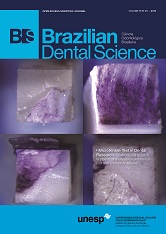New Trends in Dentin Bonding: Treatment with chlorhexidine, hyaluronic acid, vitaminc C and green tea
DOI:
https://doi.org/10.14295/bds.2013.v16i3.876Resumo
Objective: The aim of this study was to evaluate the bond strength of dentin treated with chlorhexidine, hyaluronic acid, vitamin C and green tea. Material and Methods: The roots of 50 bovine teeth were removed and buccal coronal dentin was exposed. After acid-etching, the specimens were divided into 5 groups (n = 10), according to the dentin treatment strategy: CO - untreated dentin; CHX - treated with 2 wt% chlorhexidine for 30 sec; HA - treated with 1 wt% hyaluronic acid for 30 sec; VC - treated with 10 wt% vitamin C for 30 sec; GT - treated a 1% green tea extract for 30 sec. Adper Single Bond was then applied to the treated according to the manufacturer's recommendations. The specimens were restored with a 4-mm thick layer of the resin composite, which was polymerized for 40 sec. The specimens were stored in distilled water at 37°C for 24 h and sectioned into 1x1 mm2 sticks containing the adhesive interface. Microtensile bond strength testing was performed with a universal testing machine at a cross-head speed of 1.0 mm/min. Results: The results were analyzed with one-factor ANOVA and Tukey’s multiple comparison tests. GT group presented the highest values bond strength (29.4±3.1)a, but no significant difference compared to the other experimental groups HA(26.7±3.1)ab, CHX(25.4±2.6)ab and VC(22.4±6.0)b. Bond strengths of experimental groups were not significantly different from the CO. Conclusion: Immediate bond strength was preserved after acid-etched dentin was treated.
Keywords: Chlorhexidine. Hyaluronic acid. Vitamin C. Green tea. Bond strength.
Downloads
Downloads
Arquivos adicionais
Publicado
Como Citar
Edição
Seção
Licença
TRANSFERÊNCIA DE DIREITOS AUTORAIS E DECLARAÇÃO DE RESPONSABILIDADE
Toda a propriedade de direitos autorais do artigo "____________________________________________________________________" é transferido do autor(es) para a CIÊNCIA ODONTOLÓGICA BRASILEIRA, no caso do trabalho ser publicado. O artigo não foi publicado em outro lugar e não foi submetido simultaneamente para publicação em outra revista.
Vimos por meio deste, atestar que trabalho é original e não apresenta dados manipulados, fraude ou plágio. Fizemos contribuição científica significativa para o estudo e estamos cientes dos dados apresentados e de acordo com a versão final do artigo. Assumimos total responsabilidade pelos aspectos éticos do estudo.
Este texto deve ser impresso e assinado por todos os autores. A versão digitalizada deverá ser apresentada como arquivo suplementar durante o processo de submissão.




























